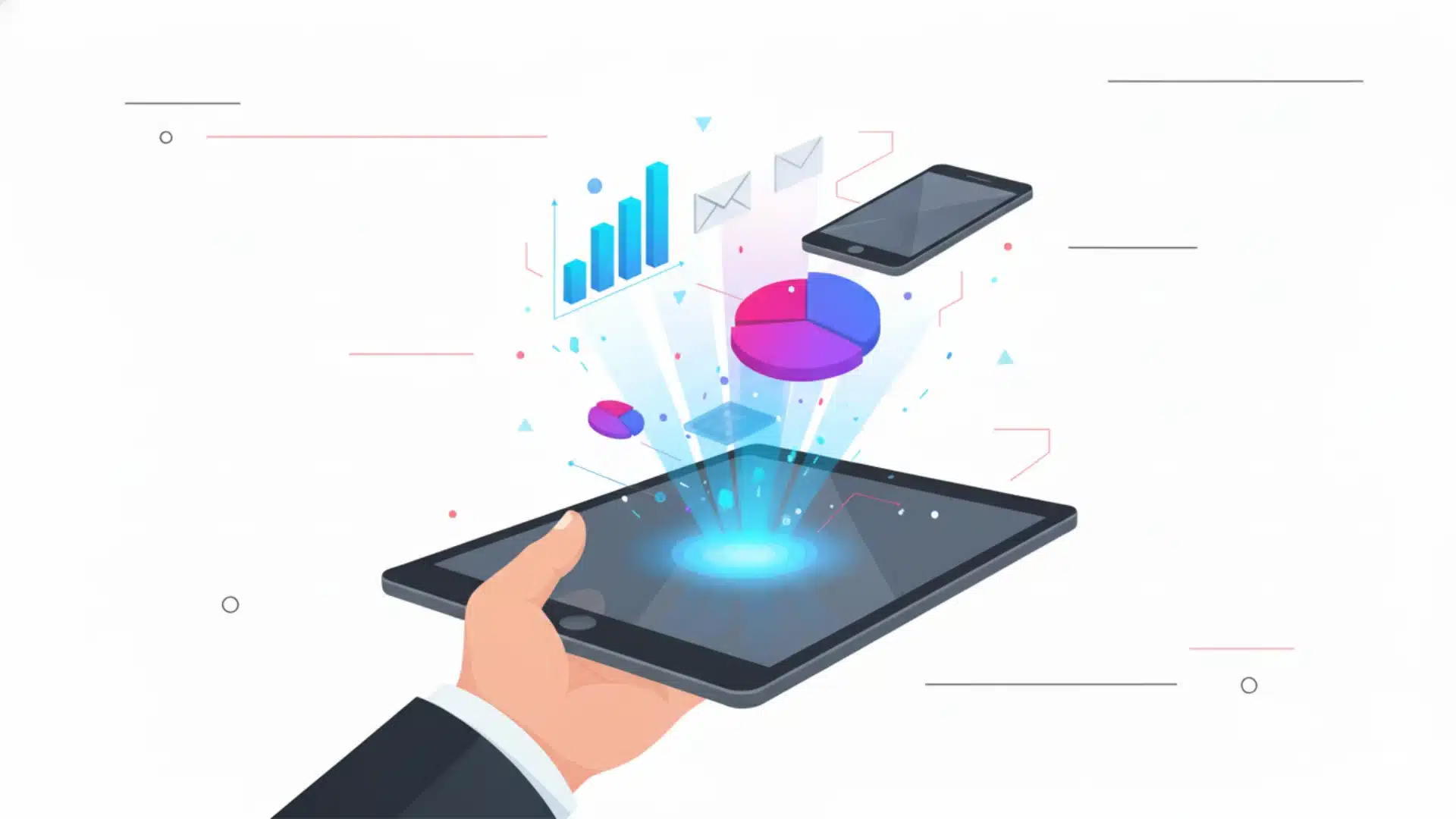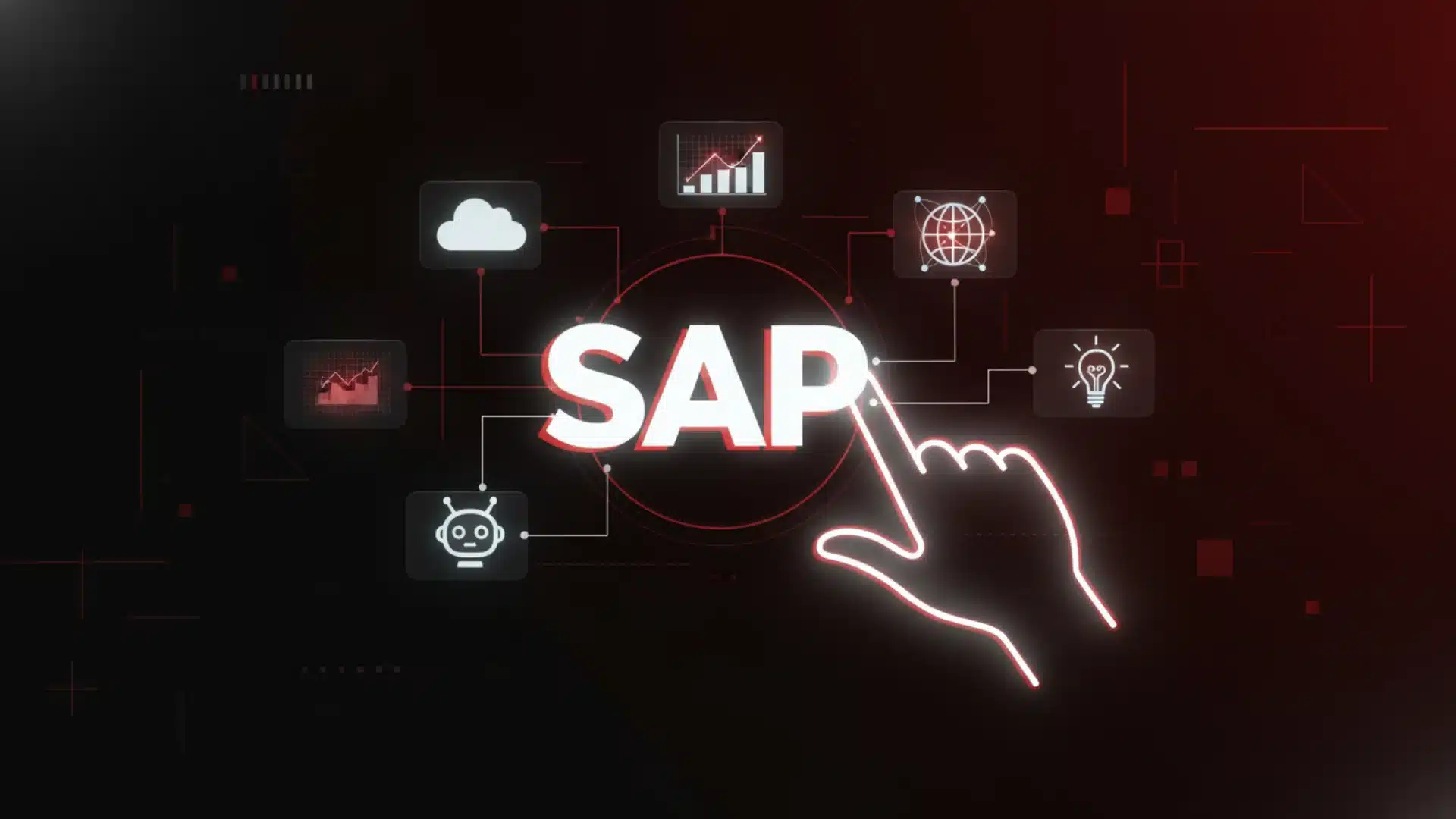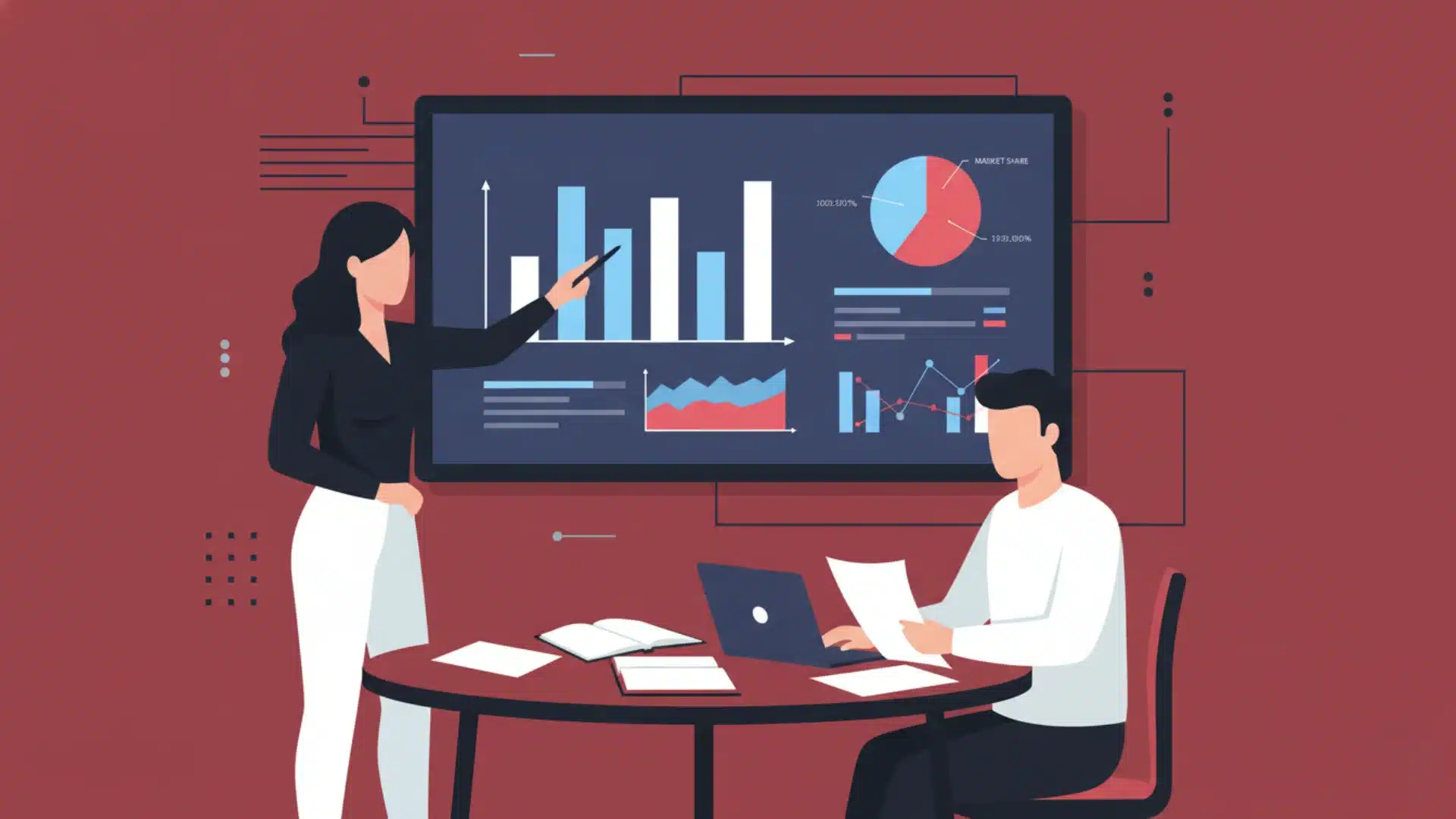Wondering about the real MVP development cost in 2026? You’re not alone. The price tag for building a Minimum Viable Product can vary widely, from $10,000 to over $150,000, leaving many entrepreneurs confused about how to budget properly.
In this guide, we’ll break down exactly what you’ll pay for MVP development in 2026, the factors that influence these costs, and practical ways to keep your budget under control. Whether you’re a startup founder or a product manager, you’ll get clear answers about MVP development cost without any confusing technical jargon.
Let’s dive into the numbers so you can plan your MVP with confidence and avoid any expensive surprises along the way.
What Is an MVP and Why It’s Worth the Investment
A Minimum Viable Product (MVP) is the simplest version of your product that solves your customers’ core problem. Think of it as the bare minimum you need to build to start getting real feedback from users.
The MVP concept was popularized by Eric Ries in his book “The Lean Startup.” He defined it as: “The version of a new product which allows a team to collect the maximum amount of validated learning about customers with the least effort.”
Here’s why investing in an MVP makes financial sense:
Test Before You Invest Fully
According to CB Insights, 42% of startups fail because they build products nobody wants. An MVP lets you test your idea in the real world before spending your entire budget on a complete product.
Faster Time to Market
Launching an MVP takes 3-4 months on average, compared to 9+ months for a full product. This means you can start getting user feedback and potentially earning revenue much sooner.
Attract Investors
Y Combinator reports that startups with MVPs and early user traction are 4 times more likely to receive funding. Investors love seeing real-world results rather than just ideas on paper.
Save Money and Reduce Risk
Building an MVP typically costs just 10-30% of what a full product would cost. If your idea doesn’t gain traction, you’ve risked much less capital.
According to a 2024 Startup Genome report, startups that use an MVP approach have a 60% higher success rate than those that launch with fully-featured products.
Complete MVP Development Cost Breakdown for 2026
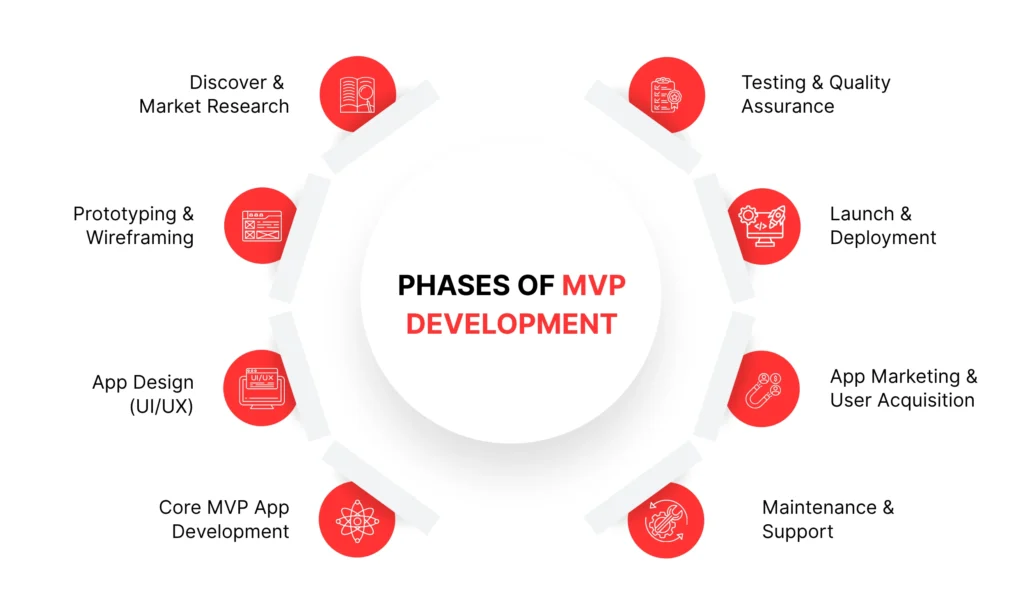
Let’s get into the actual numbers. Here’s what you can expect to pay for MVP development in 2026, broken down by stage:
Pre-Development Costs: Research, Validation, and Planning
This crucial first phase involves market research, idea validation, and creating a development plan.
| Item | Cost Range | Timeline |
| Market Research | $1,000-$10,000 | 1-3 weeks |
| User Interviews | $500-$5,000 | 1-2 weeks |
| Competitive Analysis | $1,000-$7,500 | 1-2 weeks |
| Requirements Documentation | $1,500-$5,000 | 1-2 weeks |
Total Pre-Development: $3,000-$27,500
Data from Startups.com shows that teams who spend at least 20% of their MVP budget on this pre-development phase are 3 times more likely to build a successful product.
Design and Prototyping Expenses
Before any coding begins, you’ll need designs and interactive prototypes.
| Item | Cost Range | Timeline |
| User Experience (UX) Design | $2,000-$15,000 | 1-3 weeks |
| User Interface (UI) Design | $2,500-$20,000 | 2-4 weeks |
| Interactive Prototype | $1,500-$10,000 | 1-2 weeks |
Total Design and Prototyping: $6,000-$45,000
The complexity of your user flows will significantly impact this cost. For example, an e-commerce MVP with user accounts, product listings, shopping cart, and checkout will cost more to design than a simple landing page with email signup.
Core Development Costs: The Biggest Part of Your Budget
This is where most of your budget will go – the actual building of your MVP.
| Item | Cost Range | Timeline |
| Frontend Development | $10,000-$40,000 | 4-8 weeks |
| Backend Development | $15,000-$70,000 | 6-12 weeks |
| Database Setup | $3,000-$15,000 | 1-3 weeks |
| API Integrations | $3,000-$25,000 | 2-4 weeks |
Total Core Development: $31,000-$150,000
The wide range here depends on your MVP’s complexity, the technologies used, and how many features you include. Remember: every feature you add increases both cost and development time.
Testing and Quality Assurance Costs
Quality matters even in an MVP. Poor user experience due to bugs can kill your product before it gets traction.
| Item | Cost Range | Timeline |
| Functional Testing | $2,000-$10,000 | 1-3 weeks |
| User Acceptance Testing | $1,500-$7,500 | 1-2 weeks |
| Performance Testing | $1,000-$5,000 | 1 week |
| Bug Fixing | $3,000-$15,000 | 2-4 weeks |
Total Testing and QA: $7,500-$37,500
Many startups try to cut corners here, but a 2024 report from Startup Genome found that MVPs with proper testing have a 60% higher user retention rate.
Post-Launch Expenses to Consider
Your costs don’t end when your MVP launches. You’ll need to budget for:
| Item | Monthly Cost |
| Hosting and Infrastructure | $100-$1,500 |
| Maintenance and Support | $1,000-$5,000 |
| Bug Fixes and Updates | $1,500-$7,500 |
| Analytics Tools | $50-$500 |
Total Monthly Post-Launch: $2,650-$14,500
Plan to allocate about 20% of your initial development cost for yearly maintenance and updates.
Total MVP Cost Summary for 2026
| Development Phase | Cost Range |
| Pre-Development | $3,000-$27,500 |
| Design and Prototyping | $6,000-$45,000 |
| Core Development | $31,000-$150,000 |
| Testing and QA | $7,500-$37,500 |
| Total Initial Cost | $47,500-$260,000 |
| Monthly Post-Launch | $2,650-$14,500 |
These figures reflect market rates in 2026 and can vary based on multiple factors, which we’ll explore next.
Factors That Impact Your MVP Development Cost
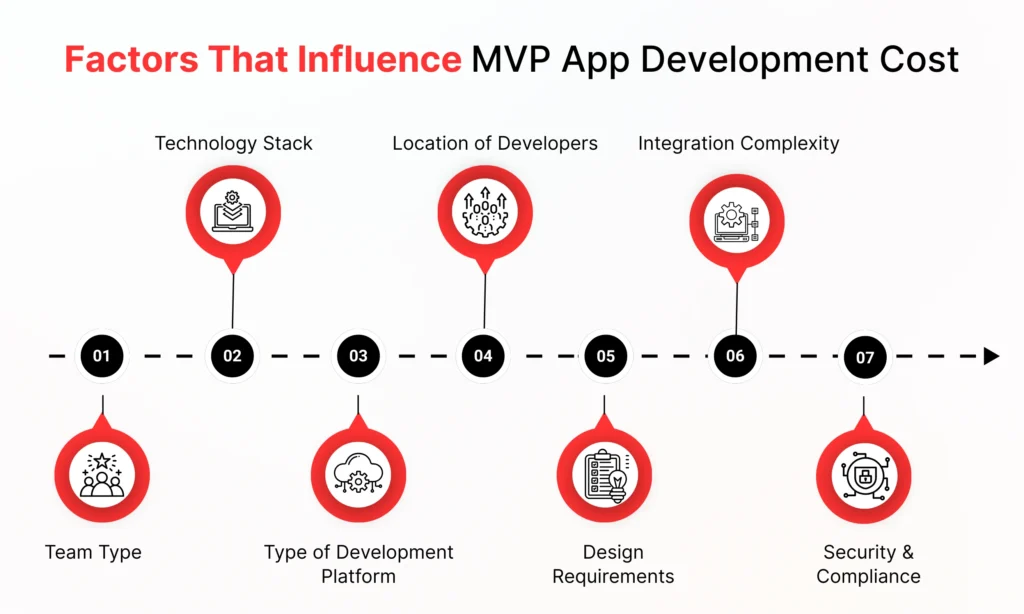
The price range for MVPs is broad because several key factors influence the final cost:
MVP Complexity Level
The complexity of your MVP is the biggest cost driver:
- Simple MVP ($15,000-$50,000): Basic functionality with minimal features, like a landing page with user signup and a core service. Example: A newsletter subscription service with content recommendations.
- Medium Complexity ($50,000-$100,000): More features and user flows, such as user accounts, payment processing, and moderate integrations. Example: A food delivery app with restaurant listings, basic ordering, and payment options.
- High Complexity ($100,000-$250,000+): Sophisticated functionality, multiple user roles, advanced integrations, and complex algorithms. Example: A telemedicine platform with video consultations, prescription management, and insurance verification.
Development Team Structure and Expertise
Your choice of development team dramatically affects costs:
| Team Type | Hourly Rate | Pros | Cons |
| Freelancers | $50-$150 | Lower rates, flexible | Management overhead, quality risks |
| Local Agency | $150-$300 | Direct communication, quality control | Higher rates |
| Offshore Agency | $35-$100 | Cost-effective, scalable | Potential communication challenges |
| In-house Team | $80-$200+ (plus benefits, equipment, etc.) | Complete control | Highest overall cost |
According to Clutch.co data, most successful MVPs in 2025 are built by small, specialized teams of 3-5 people including: a project manager, 1-2 developers, a designer, and a QA specialist.
Technology Stack
The technologies used to build your MVP affect both cost and future scalability:
- Frontend Frameworks: React and Vue.js remain popular in 2026 due to their flexibility and performance.
- Backend Technologies: Node.js, Django, and Ruby on Rails are common for MVP development due to their rapid development capabilities.
- Database Choices: MongoDB, PostgreSQL, and Firebase are frequently used for MVPs.
Using newer or specialized technologies may increase costs as developer rates for cutting-edge skills are typically higher.
How Geography Affects MVP Development Pricing
Developer rates vary significantly across regions:
| Region | Average Hourly Rate (2026) |
| United States/Canada | $150-$250 |
| Western Europe | $100-$200 |
| Eastern Europe | $50-$100 |
| Latin America | $40-$90 |
| Southeast Asia | $30-$70 |
| India | $25-$60 |
Location-based price differences reflect varying living costs, market conditions, and competition levels. However, quality can vary within any region, so rates alone shouldn’t drive your decision.
Web vs. Mobile vs. Complex MVPs: Cost Comparison
The type of MVP you’re building significantly impacts cost:
Web Application MVPs
Cost Range: $40,000-$80,000
Web apps are typically less expensive to develop than mobile apps. They require less platform-specific coding and testing across fewer devices.
Example: A web-based project management tool would cost approximately $60,000 for an MVP with user authentication, project creation, task management, and basic reporting features.
Mobile Application MVPs
Cost Range: $60,000-$150,000
Mobile apps are more expensive because they often require:
- Development for multiple platforms (iOS and Android)
- Compliance with app store requirements
- Testing across numerous devices and screen sizes
The choice between native development (separate code for each platform) and cross-platform frameworks like React Native or Flutter also affects costs. Cross-platform approaches can save 30-40% compared to building separate native apps.
Example: A basic mobile marketplace app would cost approximately $90,000 for an MVP with user profiles, listing browsing, search functionality, and in-app messaging.
Complex System MVPs
Cost Range: $150,000-$300,000+
These include systems with multiple components, such as:
- Apps with both web and mobile interfaces
- Solutions requiring AI/ML components
- Systems with IoT integrations
- Platforms with complex permissions and user roles
Example: A telehealth platform MVP with patient and doctor interfaces, video consultation capabilities, appointment scheduling, and prescription management would cost approximately $200,000.
5 Practical Ways to Reduce Your MVP Costs
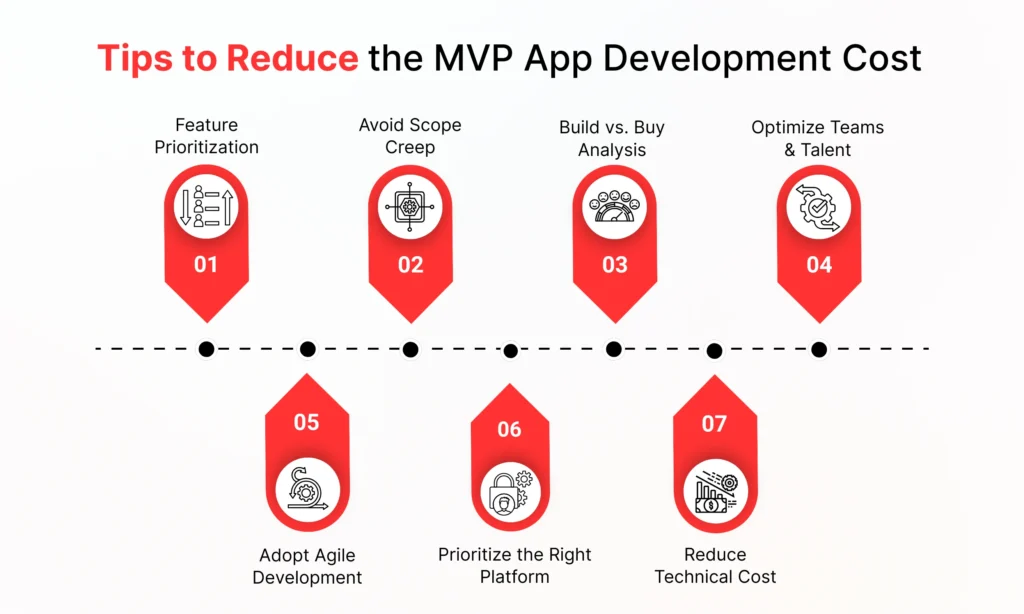
Smart planning can significantly lower your mvp development cost without sacrificing quality:
1. Focus Ruthlessly on Core Features
Every feature adds cost, time, and complexity. Ask for each feature: “Can we launch without this?”
Jason Fried, founder of Basecamp, advises: “If you’re solving a real problem, you don’t need a ton of features. You need the right features.”
For example, Amazon started by just selling books online. They didn’t build their marketplace, Prime membership, or AWS services until years later, after proving their core concept.
2. Use Existing Components and Services
Don’t build what you can buy or integrate:
- Authentication: Use services like Auth0 or Firebase Authentication instead of building custom login systems (saves $5,000-$15,000).
- Payment Processing: Integrate Stripe or PayPal rather than custom payment systems (saves $10,000-$30,000).
- Communication: Use Twilio for messaging or SendGrid for emails (saves $3,000-$10,000).
According to research by CB Insights, startups that leverage existing components can reduce development costs by 40-60% while accelerating time to market.
3. Consider a Phased Development Approach
Break your MVP into smaller phases:
Phase 1: Launch with absolute minimum features to test core concept.
Phase 2: Add the next most important features based on user feedback.
Phase 3: Scale with additional functionality once you have validation.
This approach ensures you’re only building what users actually want, avoiding wasted development cost.
4. Choose the Right Contract Type
The two main contract types for MVP development are:
- Fixed Price: You pay a set amount for predefined deliverables.
- Time and Materials: You pay for actual hours worked at an agreed rate.
For MVPs with well-defined requirements, fixed price contracts can provide budget certainty. For projects where flexibility is important, time and materials may be better, though they require more oversight.
5. Consider No-Code or Low-Code Platforms
In 2025, no-code and low-code platforms have evolved to create sophisticated MVPs:
| Platform Type | Example Tools | Best For | Cost Savings |
| No-Code | Bubble, Webflow, Appgyver | Simple web/mobile MVPs, marketplace platforms | 70-90% vs custom development |
| Low-Code | OutSystems, Mendix, Power Apps | More complex MVPs with custom logic | 40-60% vs custom development |
A 2024 Gartner report found that businesses using low-code/no-code platforms delivered MVPs 50-70% faster with an average cost reduction of 50-65% compared to traditional development.
Hidden MVP Expenses Most Founders Overlook
Watch out for these often-forgotten costs:
Legal and Compliance Costs
- Terms of Service and Privacy Policy: $1,000-$3,000
- GDPR/CCPA Compliance: $3,000-$10,000
- Industry-Specific Compliance (healthcare, finance): $10,000-$50,000+
Infrastructure and Operational Costs
- Domain and Hosting: $100-$500/year
- SSL Certificates: $50-$300/year
- Content Delivery Networks: $50-$500/month
- Email Services: $20-$200/month
Marketing and User Acquisition
Plan to spend at least 20-30% of your development budget on:
- Landing Page: $1,000-$5,000
- Initial Marketing Campaigns: $3,000-$20,000
- User Testing Sessions: $2,000-$10,000
Ongoing Development
Nearly all successful MVPs require adjustments after launch. Budget for:
- Feature Refinements: $5,000-$30,000
- Bug Fixes: $3,000-$15,000
- Performance Improvements: $2,000-$10,000
Research from Startup Genome shows that most successful startups spend about 50% of their initial development budget on improvements in the first year after launch.
How to Choose the Right MVP Development Team for Your Budget
Finding the right development partner is crucial for staying within budget while getting quality results:
Evaluate Experience and Portfolio
Look for teams with:
- Experience in your specific industry
- Examples of successful MVPs they’ve built
- Track record of on-time, on-budget delivery
Ask for references and speak with their previous clients about their experience.
Communication and Project Management
Clear communication can prevent costly misunderstandings. Ensure your development partner:
- Has a well-defined process for requirements gathering
- Provides regular progress updates
- Uses project management tools you can access
- Speaks your language fluently
Technology Expertise
Make sure the team has expertise in appropriate technologies for your MVP. For example, if you’re building a data-heavy financial application, they should have experience with secure database management and financial integrations.
Transparent Pricing
Be wary of unusually low quotes, as they often lead to scope creep or quality issues. Look for:
- Detailed breakdowns of costs
- Clear information about what happens if requirements change
- Transparent policies on additional charges
Location Considerations
While offshore development can save money, consider the trade-offs:
- Time zone differences can slow communication
- Cultural differences may affect understanding of requirements
- Quality standards can vary significantly
Many startups find a hybrid approach works best: using local project management with offshore development resources.
Ready to Build Your MVP?
Building an MVP doesn’t have to break the bank if you plan carefully and focus on what matters most. The most successful MVPs aren’t the ones with the most features or the biggest budgets—they’re the ones that solve a real problem for users in the simplest way possible.
Remember these key points:
- Focus ruthlessly on core features
- Choose the right development partner
- Plan for post-launch costs
- Be ready to iterate based on user feedback
Want to learn more about building a successful MVP? Check out our detailed guide on the complete MVP development process or explore our MVP development services if you’re ready to bring your idea to life.
Have questions about your specific MVP costs? Contact our team for a free consultation and personalized cost estimate.
Not Sure Where to Start?
We create MVP strategies that align budget, timeline and product goals.
FAQs
What is the average cost to build an MVP in 2026?
The average cost ranges from $40,000 to $80,000 for web applications and $60,000 to $150,000 for mobile apps, varying by complexity, features, and team location.
How long does it typically take to develop an MVP?
Most MVPs take 3-6 months to develop. Simple projects may need 4-8 weeks, while complex ones can take 4-8 months.
Is it cheaper to build an MVP in-house or outsource development?
Outsourcing is typically 30-50% cheaper than building in-house for most startups due to lower overhead costs.
What are the most expensive parts of MVP development?
Core development (coding) is most expensive, representing 50-70% of the total budget, followed by design work.
Can I build an MVP for less than $10,000?
Yes, using no-code platforms like Bubble, Webflow, or Adalo. These work best for concept validation but may have limitations.
How do I know if my MVP budget is realistic?
Get multiple quotes, break down requirements into must-haves versus nice-to-haves, and research similar products.
Should I choose a fixed-price or time and materials contract for MVP development?
Fixed-price works for well-defined requirements, while time and materials is better when flexibility is important.
What’s the difference in cost between web, mobile, and cross-platform MVPs?
Web MVPs cost 30-40% less than native mobile apps. Cross-platform apps fall in the middle.
Which features add the most to MVP development costs?
User authentication, payment processing, real-time features, custom admin panels, and third-party integrations.
How much should I budget for MVP maintenance after launch?
Budget 15-25% of your initial development cost annually for maintenance and updates after launch.
